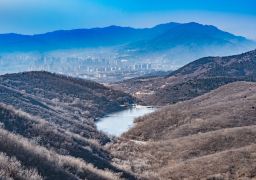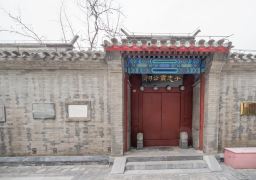The Avalokitesvara Temple That Refused to Leave is located in Purple Bamboo Grove. This is the place where temples were built early in Mount Putuo. Coupled with the legend of ‘Avalokitesvara That Refused to Leave’, it has become the most famous temple outside the ‘Three Great Temples of Putuo’. There is an endless stream of pilgrims coming to worship every day. Also, because the temple is built by the sea, it is also an ideal location for photography enthusiasts.
Walking from the Purple Bamboo Grove Zen Temple to the seaside, you can reach the Avalokitesvara Temple That Refused to Leave in a short while. This temple is not large in area, but it is recognized as the origin of the ‘Buddhist Kingdom by the Sea’ on Mount Putuo. Almost every pilgrim or tourist who comes here can tell a few allusions about ‘Avalokitesvara That Refused to Leave’. It is said that in those days, the Japanese monk Hui’e brought back the statue of Avalokitesvara Bodhisattva from Mount Wutai. When the ship passed through the Lianhua Ocean of Zhoushan Islands, the sea suddenly became stormy. The monk thought that the Bodhisattva was unwilling to go east, so he landed and left the statue. Later, a farmer on the island vacated his own house and enshrined the Avalokitesvara who refused to leave. Only then did the first ‘Avalokitesvara Temple That Refused to Leave’ on the island and the large and small Buddhist temples on Mount Putuo come into being. The original building of the temple is long gone. The temple we see now was rebuilt in the 1980s. Perhaps because of this allusion, different from traditional Chinese Buddhist temples with yellow walls, the Avalokitesvara Temple That Refused to Leave looks more like Japanese architecture. Although there are not many ancient relics in the temple, the legendary story about this place is widely known, so the incense is extremely prosperous every day. In addition to the imitation Tang Dynasty eleven-faced Avalokitesvara statue enshrined in the main hall, there is also a ‘Thirty-three Avalokitesvara Spiritual Sites’ corridor on the west side of the temple, enshrining 33 Avalokitesvara statues. The devout can worship one by one. The Sea View Pavilion directly opposite the Avalokitesvara Temple That Refused to Leave is a good place to view the sea. When there are not many tourists, you can take a rest here. The Chaoyin Cave next to it is also in a secluded location and is suitable for enjoying the sea view and listening to the bustling tide. There are also many tourists taking pictures in front of the stele of ‘Prohibited Place for Self-Immolation and Burning Fingers’.The opening hours are from 06:00 to 17:30 all year round. The specific business status is subject to the opening situation on that day.










